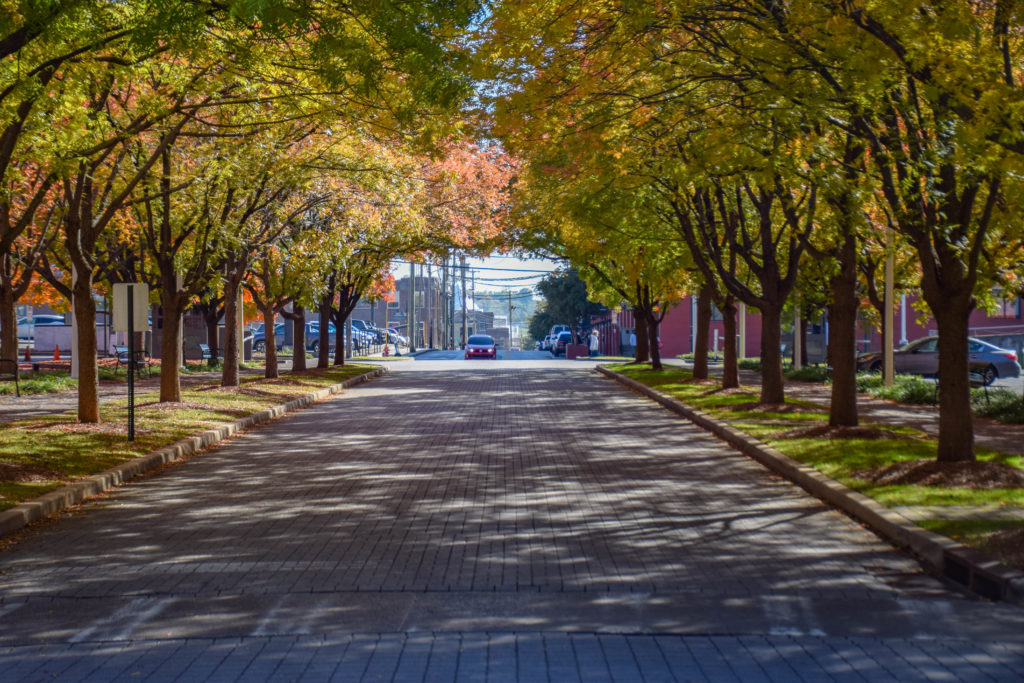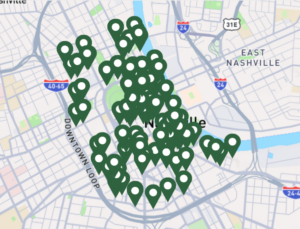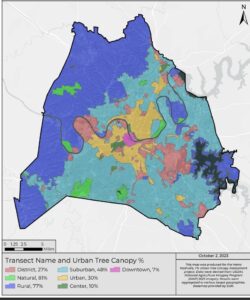
Downtown Nashville is now officially designated as an outdoor library for trees.
The “Nashville Downtown Arboretum” boasts more than 50 tree species along sidewalks, boulevards and parks in the heart of the city. Each species, like the overcup oak and sweetbay magnolia, has been mapped, and a small portion of the more than 3,000 trees are marked with QR codes to provide more information for passersby.
 Courtesy Downtown Nashville Partnership
Courtesy Downtown Nashville Partnership The Nashville Downtown Arboretum has at least 50 species of trees mapped.
“Our urban tree canopy provides visual proof that we can grow responsibly, sustainably, and preserve this critical form of infrastructure,” Mayor Freddie O’Connell said in a statement.
Despite the designation, downtown contains one of the lowest tree canopy covers in Nashville. The city’s most recent tree canopy study shows the downtown transect, an area slightly larger than the traditional downtown boundary, with 7% canopy using 2021 imagery. Another boundary used in the study for downtown shows 8% canopy cover.
 Courtesy Metro Nashville
Courtesy Metro Nashville Nashville is divided into seven main transects. The suburban and rural transects comprise 87% of Nashville’s urban tree canopy, largely thanks to the hilly, western area now known as the “Highland Rim Forest.”
The downtown census blocks that include the arboretum have canopy cover ranging from just 4% to 15%, according to the Tree Equity Score, a data tool created by the nonprofit American Forests.
A community leader stated an inaccurate canopy estimate last week while announcing the arboretum with the mayor and other city officials, suggesting the downtown canopy increased from 8% in 2021 to now 18%, the Tennessean reported. The city has planted 263 trees downtown since July 2020, according to Rebecca Dohn, who helped oversee the city’s canopy study with Metro Water Services. The new trees would likely represent a less than 1% increase in canopy.
More: With fewer trees and more concrete, Nashville is heating up. What’s the plan? | WPLN News
The city has faced backlash in recent years for tree chopping in the downtown area. The city allowed the removal of habitat near the Schermerhorn Symphony Center for a migrating purple martin brood, as well as plans to cut cherry trees for a temporary stage during the NFL Draft in 2019 — ultimately, three dead cherry trees were cut but the other trees were transplanted to downtown streets and may now be considered part of the arboretum.
 Caroline Eggers WPLN News
Caroline Eggers WPLN NewsThe Nashville Symphony cut about 30 of its trees to remove habitat for a purple martin brood on May 17, 2022.
The city’s transportation department and the Nashville Downtown Partnership initiated the arboretum project in 2022. Downtown is considered a “level one” arboretum, which the Tennessee Urban Forestry Council defines as public spaces with at least 30 species of trees.
The new arboretum is Nashville’s second space to be classified as such in the past year.
Last year, Fannie Mae Dees Park became an arboretum, thanks to efforts by the Hillsboro-West End Neighborhood Association, which recently accepted a grant to add tags to the trees. The Tennessee Urban Forestry Council classifies the space, called the “Hillsboro-West End Arboretum,” as a “level two” arboretum, meaning it must have at least 60 species mapped.
Vanderbilt University is also considered an arboretum, with nearly 200 species of trees and shrubs across the campus. An area around Shelby Avenue in East Nashville, Andrew Jackson’s Hermitage, and the Betty Brown Tree Trail in downtown’s Riverfront Park also contain arboretums.

